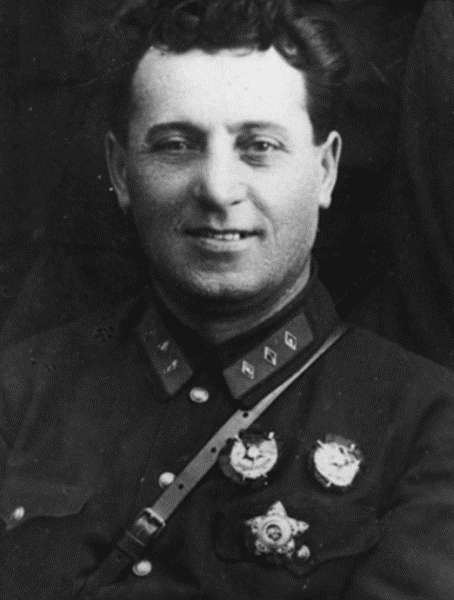Birth name Hayk Bzhishkyan Name Hayk Bzhishkyan Rank Comcor | Years of service 1914–1935 Nickname(s) Gai | |
 | ||
Born 6 February 1887
Tabriz, Iran ( 1887-02-06 ) Allegiance Russian Empire
Soviet Union Commands held 24th Rifle Division
1st Army
42nd Rifle Division
1st Caucasus Cavalry Division
2nd Cavalry Corps
3rd Cavalry Corps Died December 11, 1937, Moscow, Russia Battles and wars World War I, Russian Civil War, Polish–Soviet War Service/branch Imperial Russian Army, Red Army Similar People Sergey Kamenev, Mikhail Tukhachevsky, Alexander Yegorov, Tadeusz Jordan‑Rozwadowski, Semyon Budyonny | ||
Hayk Bzhishkyan (Armenian: Հայկ Բժշկյան, Persian هایک پزشکیان, Russian: Гайк Бжишкян, also known as Guy Dmitrievich Guy, Gai Dmitrievich Gai (Гай Дмитриевич Гай), Gaya Gai (Гая Гай), or Bzhishkyan, 18 February [O.S. 6 February] 1887 – 11 December 1937), was a Soviet military commander of the Russian Civil War and Polish-Soviet War.
Contents
Biography
Hayk was born in Tabriz, Iran to a family of teachers; his mother was Persian and his father an Armenian socialist (a member of Social Democrat Hunchakian Party) who had taken refuge from Tsarist authorities in Persia during the 1880s. He returned to Russia in his teens, was an activist and journalist in Tiflis, where he studied at the Armenian Theological Seminary, and spent five years in jail for revolutionary activities before he was drafted in 1914. Because of his background, Gai had been assigned to the Turkish front, where repeated bravery under fire won him a battalion commander's stars, the Cross of St. George (3rd and 4th class), and the Order of St. Anna, all awarded by General Nikolai Yudenich. Captured by the Turks, he escaped and returned, badly wounded, to Russia on the eve of the February Revolution. During World War I, Bzhishkyan rose to the rank of captain. Gai had become a Bolshevik before the October Revolution. (Lincoln, p. 413) He became a military commander in 1918, when he fought against the Czech Legion ("White Czechs") and the Orenburg Cossacks of ataman Alexander Dutov.
During the Polish–Soviet War of 1920, he helped Tukhachevsky drive the Poles back to Warsaw. Gai was appointed commander of the III Cavalry Corps ("Kavkor"), attached to the IV Army, and consisting of the 10th Division (N. D. Tomin) and the 15th (Kuban) Division (V. I. Matuzenko), with the 164th Rifle Brigade in support. In Tukhachevsky's plan, the role assigned to the Kavkor was "of the utmost importance". It was to operate on the extreme right wing of the Soviet advance and turn the flank of the Polish defence lines, thus allowing them to be rolled up by the attacking armies. The Kavkor advanced rapidly, taking Vilnius on July 14, Grodno (where the Red cavalry encountered tanks for the first time) on July 22, reaching the Vistula in the second week of August, and cutting the crucial Warsaw-Gdańsk railway.
However, the Polish counter-attack resulted in the encirclement of the IV Army. Gai's Kavkor attempted to break out. After several engagements, it was finally pinned against the German (East Prussian) border by the pursuing Poles. The Kavkor crossed the border on August 26, and Gai was interned by the Germans in the Salzwedel camp near Berlin.
Bzhishkyan was the People's Commissar of the Army and Navy of the Armenian SSR and later a military history lecturer and researcher in 1922. From 1924 to 1925, he was the chief of the military garrison in Minsk. In 1926, he continued his studies at the Military Academy of the General Staff. Upon graduation in 1927, Bzhishkyan managed the Frunze department. He was a professor and the Head of the Department of War History and Military Art in the Zhukovsky Air Force Engineering Academy from 1933 to 1935.
He was twice awarded with the Order of the Red Banner; in 1919 for battles in the Volga Region of 1918 and in 1920 for the Polish campaign.
Arrest and death
In June 1935, he was dismissed from all his posts and the army and was also expelled from the Communist party. On 3 July 1935, he was arrested and accused of "creating a military-fascist organization in the Red Army" by the Military Collegium of the Supreme Court of the USSR. He was also accused of having a private conversation with a non-party while drunk and stating, "it is necessary to remove Stalin". On 15 October 1935, Bzhishkyan was sentenced by the Special Council of the NKVD on charges of involvement in the counter-revolutionary group to 5 years in detention camps. While being sent to the Yaroslavl prison on 22 October 1935, he ran, but after a few days he was arrested by the NKVD.
He spent two years in detention. On 11 December 1937, during the Great Purge, Bzhishkyan was shot. His books were declared politically harmful and banned. After Stalin's death, he was rehabilitated on 21 January 1956 and restored in the party posthumously.
Memory
The town of Gai, Armenia was renamed in his honor. A USSR postage stamp of Bzhishkyan's portrait was made in 1967. The passenger river motor ship (riverboat) Komdiv Gai (Комдив Гай, 1963) bears his name, although according to his rank, it should be Komkor Gai, as Gai was a Commander of Corps. There are streets named after him in the cities of Grodno, Minsk, Samara, Orenburg and Stary Oskol. Guy Boulevard in Togliatti is also named for Bzhishkyan.
Honors and awards
Bzhishkyan is also an honorary citizen of Minsk.
Commands
Hayk Bzhishkyan commanded some regiments, divisions and higher military formations:
Name
Hayk's first name is sometimes given as Gaia, Гая, or Gai, as well as Ghaia or Ghai; the patronymic is sometimes spelt as "Dimitrievich" or "Dimitriyevich" or "Dmitriyevich"; the last name also spelt as Bzhishkyants (Бжишкянц); in Polish sources related to Polish-Soviet War he is referred to as either Gaj Brzyszkian, Gaj Dimitrijewicz Gaj or Gaj-Chan (Khan), or Gay-Khan (English spelling). His first name, Гайк, is a Russian transliteration of "Haik", which was further corrupted in various Latinizations.
